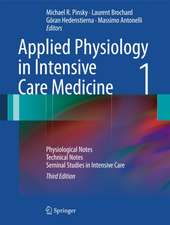Emergency and Disaster Medicine: Proceedings of the Third World Congress Rome, May 24–27, 1983
Editat de C. Manni, S. I. Magalinien Limba Engleză Paperback – 20 noi 2011
Preț: 1111.26 lei
Preț vechi: 1169.74 lei
-5% Nou
Puncte Express: 1667
Preț estimativ în valută:
212.64€ • 222.47$ • 176.64£
212.64€ • 222.47$ • 176.64£
Carte tipărită la comandă
Livrare economică 03-17 aprilie
Preluare comenzi: 021 569.72.76
Specificații
ISBN-13: 9783642692642
ISBN-10: 3642692648
Pagini: 532
Ilustrații: XVII, 511 p.
Dimensiuni: 170 x 244 x 32 mm
Greutate: 0.84 kg
Ediția:Softcover reprint of the original 1st ed. 1985
Editura: Springer Berlin, Heidelberg
Colecția Springer
Locul publicării:Berlin, Heidelberg, Germany
ISBN-10: 3642692648
Pagini: 532
Ilustrații: XVII, 511 p.
Dimensiuni: 170 x 244 x 32 mm
Greutate: 0.84 kg
Ediția:Softcover reprint of the original 1st ed. 1985
Editura: Springer Berlin, Heidelberg
Colecția Springer
Locul publicării:Berlin, Heidelberg, Germany
Public țintă
ResearchDescriere
C. Manni The focusing of general interest and of many disciplines on disaster medicine is an interesting and recent phenomenon in our society. Disasters have by now left the his torical and philosophical sphere and finally entered the operational arena. Modern man, in other words, no longer accepts disasters in a passive and fatalistic manner, but claims to be able to control them like so many other forces of nature. The new approach is aimed at preventing, containing, and remedying the invariably tragic consequences of these events. The role of medicine in this context is of fundamental importance and is charac terized by two main aspects: application of techniques of intervention appropriately and effectively, and collaboration with the general organization, assuming responsi bility for the protection of health and the treatment of injuries. Following a period of more or less chaotic growth, during which sectionalism and empirical interests prevailed, and localized aspects of this new discipline underwent considerable development, a need is now felt to propose and realize a more com prehensive scientific approach. It has become necessary to identify and to rationally analyze the individual components of this branch of medicine. As in any analysis, the recognition of the "object" of the research is of fundamental importance: hence the title of this first round table: "Types and Events of Disaster.
Cuprins
Introductory Speeches.- Address Delivered to the Holy Father by the President of the Congress.- Science and Conscience: Undeniable Requirements for Effective Emergency Medicine.- Inaugural Address by the President of the Congress.- The Club of Mainz.- Message from the Representative of the World Health Organization.- The Role of the Red Cross.- Introductory Report on Civil Defense in Italy.- An Ethical Evaluation of Emergency Medicine.- Resuscitation Potentials in Mass Disasters.- The Best Medicine Is to Stave Off Megadisasters.- Types and Events of Disasters.- The World Health Organization in Burn Disasters.- The Genesis of Earthquakes: What Is Necessary for Our Protection?.- An Overview of Aircraft Disasters.- Radiation Accidents and Their Emergency Management.- Types of Intervention in Natural and Man-Made Disasters.- Coping with Accidents and Emergencies Involving the Release of Potentially Toxic Chemicals.- The Salvageability of Disasters Victims: The Scientific Basis for Disaster Planning, Rescue, and Response.- Civil Defense Planning for Nuclear War.- Emergency Medical Support in Radiation Accidents.- Organization of Radiological Emergency in France.- Disaster Management in New Zealand.- Training and Education in Disasters.- A Hypothetical Regional Health Education Program on Disasters and Major Risks.- Community Disaster: Planning and Training Aspects.- The Training and Information of Personnel Concerned with Prevention, Supervision, and Intervention of Major Hazards.- Training of Cardiopulmonary Resuscitation in Japan.- A Television-Centered Public Campaign for the Propagation of General Training in Basic Cardiopulmonary Resuscitation.- Disaster and Emergency Medicine: Definitions, Education.- Nutrition, Pain, and Infection Control.- Pain Control in Mass Casualties.- Intramuscular Ketamine: An Alternative Pain Treatment for Use in Disasters?.- Communicable Diseases and Epidemiological Surveillance in Natural Disasters, with Special Emphasis on Developing Countries.- Investigations on Epidemiology and Prophylaxis of Nosocomial Infections in Intensive Care Units.- Risk of Infection in Natural Disasters: Experiences and Perspectives.- Nutritional Problems of Refugees: Three Years’ Experience in the Somali Camps.- Organization of Services in Disasters.- Integration of Disaster Relief Services.- The Anesthetist in Emergency and Disaster Medicine.- A New Approach in Planning Disaster Relief: A Disaster Relief Center.- The Use of Communications Satellite Systems in Major Disaster Situations.- Functional Outlines and Design of Mobile Emergency Care Units for Use in Disasters.- The Role of Air Transportation in Disaster Relief.- Does the Plan Work? Four and a Half Years’ Experience with Disasters at the Shaarei Zedek Medical Center (1975–1979).- Medical Assistance at Automobile Racing Circuits.- Casualties Prediction, Risk Assessment, and Forensic Medicine Aspects.- Prediction of High-Consequence Events Having Low Probabilities.- Technological Risk Assessment with Some Examples from Energy Production and Medical Technology.- Economic Aspects of Emergency System Evaluation.- Operational Intervention Relevant to Forensic Medicine with Special Reference to the Various Environmental Situations and the Typology of Catastrophe.- Real-Time Intervention of Teams on Site for Identification of Victims.- The Odontostomatological Aspects of Victim Identification.- Clinical Aspects of Trauma.- An Example of International Cooperation: WHO Cooperation in Radiopathology.- The General Surgeon and the Early Care of Injured Patients.- The Colloid-Crystalloid Controversy of Fluid Resuscitation.- Artificial Blood for Emergency Situations.- The Aspect of Nutrition in Trauma.- Management of Thoracic Injuries with Flail Chest.- A Hypothesis to Be Studied: Antibiotic Resuscitation.- Pathophysiological Aspects in Trauma.- Cardiovascular Changes with Major Burn Injuries.- Pathophysiology of Hemocoagulation and Respiratory Complications in Connection with the Crush Syndrome.- Accidental Radiation Injuries: Radiation Burns.- Accidental Radiation Injuries: Whole-Body Radiation Syndromes.- Advances in Cardiopulmonary Resuscitation.- Advances in Cardiopulmonary-Cerebral Resuscitation Relevant to Disaster Medicine.- Open-Chest Cardiopulmonary Resuscitation.- Postischemic Hypoperfusion: Its Relevance for Resuscitation of the Brain After Ischemia.- Clinical Trials of Brain Resuscitation.- Neurological Aspects of Reanimatology.- Resuscitation: State of the Art.- Abdominal Pumping: A Promising Technique?.- Head and Spinal Injuries.- Classification and Triage of Brain Injuries.- Acute Management of Severe Head Injuries.- Intensive and Reanimatory Therapy for Patients with Cervical Trauma.- National and International Civilian Military Collaboration.- Organization of Early Emergency Health Intervention in Natural Disasters.- International Military-Civilian Collaboration: Today’s Challenges for Saving Lives.- The Contribution of Military Medical Services in Mass Casualty Situations.- The Coordination of Health Services in Natural Disasters.- Civil-Military Collaboration in Denmark.- Experiences with Disaster Medicine in the ICRC Surgical Field Hospital in Khao I Dang During the Kampuchean Disaster Relief in 1980.- Civil Defense: Background — Legislation — the Role of Information.- Land, Sea, and Air Rescue.- Land, Sea, and Air Rescue: Introduction.- Particular Medical Aspects of Land Rescue Performed by the Italian Army.- Particular Medical Aspects of Sea Rescue Performed by the Italian Navy.- Particular Medical Aspects of Air Rescue and Aid Performed by the Italian Air Force.- The Importance of Helicopter Rescue Missions for the Immediate and Most Efficient Primary Treatment of Polytraumatized Patients.- Training Program and 10 Years’ Experience of a Reparation Rescue Flight System in West Germany.- The Air Transportable Hospital Concept of the United States Air Force.- Conclusion.- A Constructive Proposal: The Application of the High Technologies of Defense to Biology and Medicine.- Concluding Remarks on the Third World Congress on Emergency and Disaster Medicine.













